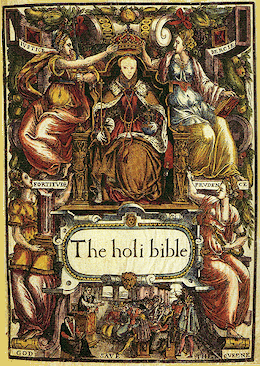Textus Receptus Bibles
Bishops Bible 1568
| 27:1 | And thou shalt make an aulter of Sittim wood, fiue cubites long & fiue cubites broade, it shalbe foure square, and three cubites hye |
| 27:2 | And thou shalt make vnto it hornes in his foure corners: his hornes shalbe of the same as it is of, and thou shalt couer it with brasse |
| 27:3 | And make his ashpannes for his ashes, his beesomes, his basons, his fleshehookes, his firepannes: and all the vessels thereof thou shalt make of brasse |
| 27:4 | And thou shalt make vnto it a grediren also like a net of brasse, and vpon that net shalt thou make foure brasen ringes in the foure corners therof |
| 27:5 | And thou shalt put it vnder the compasse of the aulter beneath, that the net may be in the middest of the aulter |
| 27:6 | And thou shalt make two barres for the aulter of Sittim wood, and couer them with brasse |
| 27:7 | And let them be put in the ringes along by the sides of the aulter, to beare it with all |
| 27:8 | And make the aulter holowe with boordes: euen as it was shewed thee in the mount, so shalt thou make it |
| 27:9 | And thou shalt make the court of the tabernacle on the south side, euen full south: the curtaines for the court shalbe of whyte twined silke of an hundreth cubites long for one side |
| 27:10 | And twentie pillers therof, with their twentie sockets of brasse: but the knops of the pillers and their whopes shalbe siluer |
| 27:11 | In likewise on the north syde there shalbe curtaynes of an hundred cubites long, and twentie pillers, with their twentie sockets of brasse, and the knops and the whopes of siluer |
| 27:12 | And the breadth of the court whiche is westwarde, shall haue curtaynes of fiftie cubites, and the pillers of them shalbe ten, and the sockets of them ten |
| 27:13 | Fiftie cubites shalbe in the court eastwarde, euen full east |
| 27:14 | The curtaynes of one syde shalbe of fifteene cubites, the pillers of them three, and the sockets three |
| 27:15 | And likewise on the other side shalbe curtaines of fifteene cubites, with their three pillers and three sockets |
| 27:16 | And in the gate of the court shalbe a vayle of twentie cubites of blewe silke, purple, and scarlet, and white twyned silke wrought with needle worke, and foure pillers with their foure sockets |
| 27:17 | All the pillers rounde about the court shalbe whoped with siluer, and their knoppes shalbe of siluer, and their sockets of brasse |
| 27:18 | The length of the court shalbe an hundred cubites, and the breadth fiftie on euery side, and the heyght of the curtaynes shalbe fiue cubites of whyte twyned silke, and their sockettes of brasse |
| 27:19 | All the vessels of the tabernacle in all maner of seruice, and the pinnes therof, yea and all the pinnes also of the court, shalbe of brasse |
| 27:20 | And thou shalt commaunde the chyldren of Israel that they geue thee pure oyle oliue beaten for the light, that they may make the lampes to borne alwayes |
| 27:21 | In the tabernacle of the congregation without the vayle whiche is before the witnesse, shall Aaron & his sonnes dresse the lampes both euening and morning before the Lorde: and it shalbe a statute for euer vnto the generations of the chyldren of Israel |

Bishops Bible 1568
The Bishops' Bible was produced under the authority of the established Church of England in 1568. It was substantially revised in 1572, and the 1602 edition was prescribed as the base text for the King James Bible completed in 1611. The thorough Calvinism of the Geneva Bible offended the Church of England, to which almost all of its bishops subscribed. They associated Calvinism with Presbyterianism, which sought to replace government of the church by bishops with government by lay elders. However, they were aware that the Great Bible of 1539 , which was the only version then legally authorized for use in Anglican worship, was severely deficient, in that much of the Old Testament and Apocrypha was translated from the Latin Vulgate, rather than from the original Hebrew, Aramaic and Greek. In an attempt to replace the objectionable Geneva translation, they circulated one of their own, which became known as the Bishops' Bible.